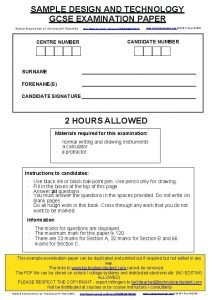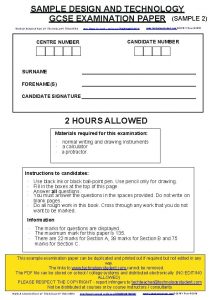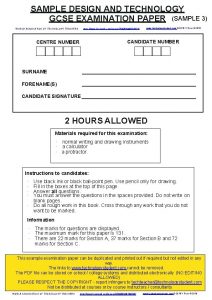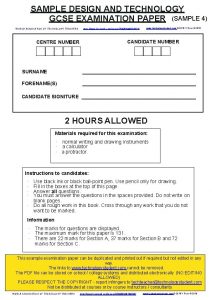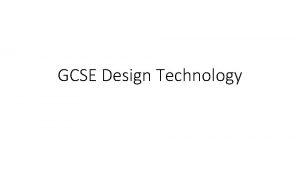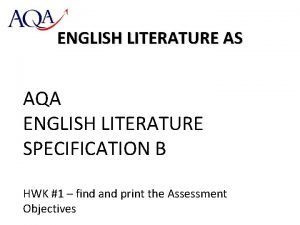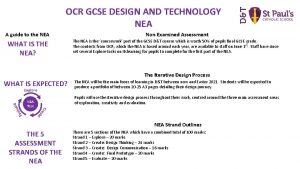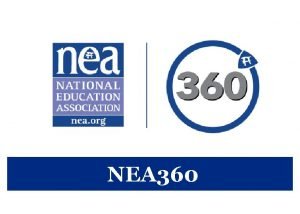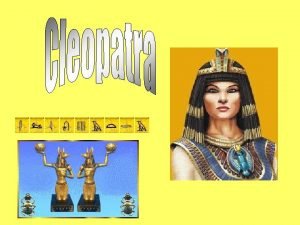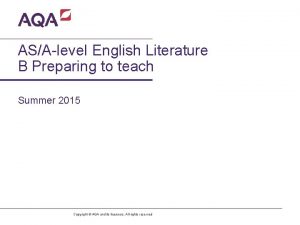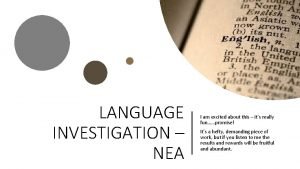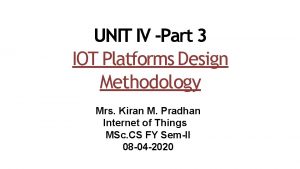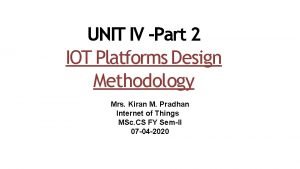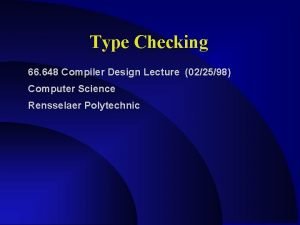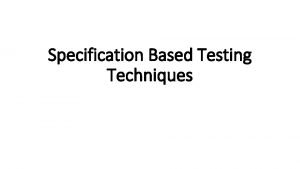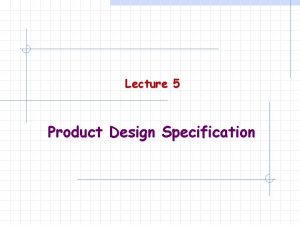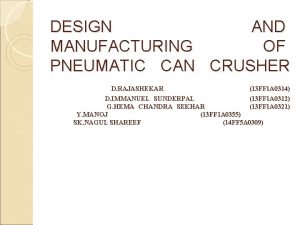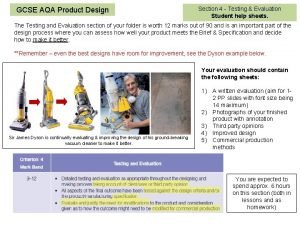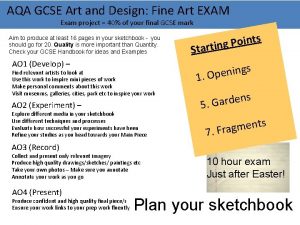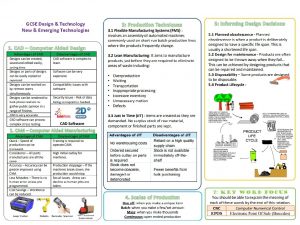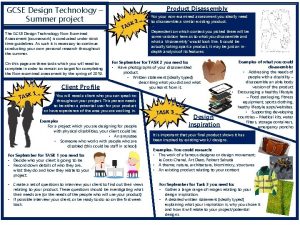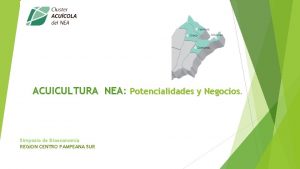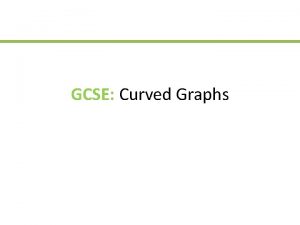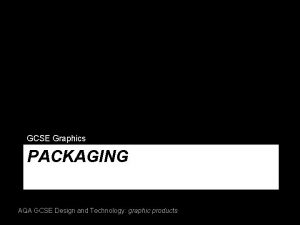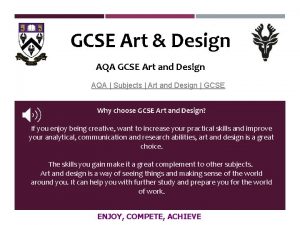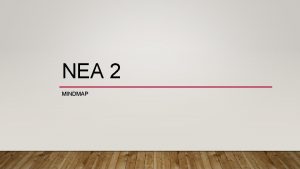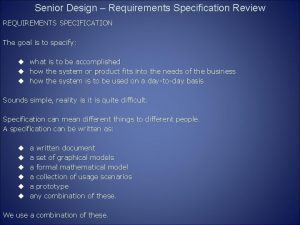GCSE Design and Technology Design 2017 Specification NEA











































- Slides: 43

GCSE Design and Technology Design 2017 Specification - NEA Guidance 2017 Specification NEA Guidance

Introductions: Mansel Davies - A Level Principal Examiner

Technical Information • • • Unitised specification Assessment in the summer Units 1 and 2 available in 2018 (20%. . 20%) Units 3 and 4 available in 2019 (30%. . 30%) Re-sit once only Three endorsed areas at both AS and A Level: Engineering Design, Fashion and Textiles, Product Design

Design and Technology 2017 Specification NEA Guidance AS Level • NEA – Non Examined Assessment – 20% of the qualification • Approximately 40 (AS) hrs of candidate work • Design & Make task – developed by learner • Internally assessed and externally moderated • Supervision and authentication – see page 27 As level Specification • Based within the same endorsed area as the written examination

Assessment Objectives AO 1 Project Identify, investigate and outline design possibilities to address needs and wants AO 2 Project Design and make prototypes that are fit for purpose AO 3 Paper/Project Analyse and evaluate – • design decisions and outcomes, including for prototypes made by themselves and others • wider issues in design and technology AO 4 Paper Demonstrate and apply knowledge and understanding of – • technical principles • design and making principles

Learner will be required to produce the following evidence: • a design brief developed by the learner • a final prototype (or prototypes) based on the design brief • additional evidence

General Aims Innovation, work collaboratively, use a range of skills from other subjects - focus on science and maths, experience real world contexts, taking a design through to a prototype/product. Specification Content 1. Core Technical Principles AS and A 2. Core Technical Principles A 3. In depth Technical Principles (endorsed area) 4. Core Design and Making principles As and A 5. Core Design and Making principles A Level

GCE Design and Technology 2017 Specification NEA Guidance Assessment Criteria (a) Identifying and investigating design possibilities. Developing a design brief and specification. Generating and developing design ideas. Manufacturing a prototype. Analysing and evaluating design decisions and prototypes. (b) (c) (d) (e) Total Marks Assessment objective 12 AO 1 12 20 AO 3 16 80 • The design context must be analysed critically. • There will be a number of possible design tasks identified. • Detailed and relevant research will be evident • Consider the needs and wants of users • Analysis of existing products • Research into past / present professionals

GCE Design and Technology 2017 Specification - NEA Guidance Assessment Criteria (a) Identifying and investigating design possibilities. Developing a design brief and specification. Generating and developing design ideas. Manufacturing a prototype. Analysing and evaluating design decisions and prototypes. (b) (c) (d) (e) Total Marks Assessment objective 12 AO 1 12 20 AO 3 16 80 • Opportunities are carefully considered before final brief. • Understand the task and the needs and wants of users. • A clearly defined design brief is evident. • A detailed Specification is generated to drive designing. • Measurable criteria included. • The Spec is used throughout the designing process.

GCE Design and Technology 2017 Specification - NEA Guidance Assessment Criteria (a) Identifying and investigating design possibilities. Developing a design brief and specification. Generating and developing design ideas. Manufacturing a prototype. Analysing and evaluating design decisions and prototypes. (b) (c) (d) (e) Total Marks Assessment objective 12 AO 1 12 20 AO 3 16 80 • 25% of the NEA • An iterative approach is required. • A range of design strategies. • Clear and effective testing. • Analysis against Spec identifies further refinements. • Testing and selection of : Materials Components Dimensions Manufacturing / production Finishing • High level skills evident

GCE Design and Technology 2017 Specification - NEA Guidance Assessment Criteria (a) Identifying and investigating design possibilities. Developing a design brief and specification. Generating and developing design ideas. Manufacturing a prototype. Analysing and evaluating design decisions and prototypes. (b) (c) (d) (e) Total Marks Assessment objective 12 AO 1 12 20 AO 3 16 80 • Another 25% of the NEA! • Stages of production timeline. • Completed prototype to schedule. • Successful high level making skills. • Excellent appreciation of materials and components • High levels of accuracy in outcome. • Prototype functions perfectly • Meeting the user needs and wants.

GCE Design and Technology 2017 Specification - NEA Guidance Assessment Criteria (a) Identifying and investigating design possibilities. Developing a design brief and specification. Generating and developing design ideas. Manufacturing a prototype. Analysing and evaluating design decisions and prototypes. (b) (c) (d) (e) Total Marks Assessment objective 12 AO 1 12 20 AO 3 16 80 • 16 Marks available. • On-going evaluation and analysis of ideas as they develop. • Appraising concepts through the iterative process. • A critical analysis and evaluation of the FINAL prototype. • User trials / testing and opinions of potential users. • Reflection on feedback and further development issues identified. • Detailed suggestions for modifications.

GCE Design and Technology 2017 Specification - NEA Guidance • • • Learners required to produce one design and make task Iterative Design Process v Linear Design Process A design brief developed by the learner A final prototype based on the design brief Design folio to meet AO’s (AO 1, AO 2 and AO 3)

GCE Design and Technology 2017 Specification - NEA Guidance • Full understanding of the design context leads to various design problems identified. • Supplementary design work will be submitted • Far more focus on development / testing • More analysis and decision making required

GCE Design and Technology 2017 Specification - NEA Guidance 5 Assessment Criteria • • • Marks are in banded descriptors (Page 34 -40) Smaller margin of tolerance Descriptors are very clear No easy marks given to candidates More freedom but less guidance

GCE Design and Technology 2017 Specification - NEA Guidance 50% of AS Qualification • Exam becomes more important • Candidates cannot ‘ride’ on the practical unit • Equal emphasis must be placed on teaching the Specification, skills, knowledge and understanding. • NEA is not less important • Onus is very candidate based

GCE Design and Technology 2017 Specification - NEA Guidance • There will be NO SET FORMAT for the NEA • Candidates / centres will need to adopt a successful approach • Informal ‘sketchbook’ and Formal ‘portfolio’ • We cannot provide too much structure – this is against the Regulatory Protocol.

GCE Design and Technology 2017 Specification - NEA Guidance Iterative Design Process (v Linear Design Process) • Open book approach • Informal sketchbook to cater for an iterative approach to design and development • Multiple starting points for project work • Think – test – reflect • Trialling and evaluating / reward risk • • https: //www. youtube. com/watch? v=16 r. Gw. TX 4 Nc. M https: //www. youtube. com/watch? v=Wc. FSZGv. Xtj. A

GCE Design and Technology 2017 Specification - NEA Guidance ‘Iterative design is a design methodology based on a cyclic process of prototyping, testing, analysing, and refining a product or process. Based on the results of testing the most recent iteration of a design, changes and refinements are made’.

DESIGN AND TECHNOLOGY Designing PORTFOLIO. . . FORMALLY QUESTIONING RESEARCH Research, Analysis and Specification TESTING KNOWLEDGE SKETCHBOOK. . . INFORMALLY SOURCES OF INSPIRATION LOOSE SKETCHES QUICK IDEAS Initial Ideas REFLECTION EXPERIMENTING Detail Design PROJECT MANAGEMENT ANNOTATION MODELLING Formative Evaluation REFLECTION FEEDBACK Summative Evaluation COMMUNICATION Thinking. . . gathering . . . . Developed Solution

GCE Design and Technology 2017 Specification - NEA Guidance Development bias (v Very structured developments) • • • Candidates need to test ideas! Analyse the results Refine the concept Test the next Iteration! Evidence of this informal process is critical

GCE Design and Technology 2017 Specification - NEA Guidance Design Brief developed by the learner at AS • • • May work within contexts Much less detail – more like titles Broad topics, no structure or guidance Candidates must do ‘more’ relevant ‘digging’ They must identify multiple design possibilities To do this they must understand the context User needs and wants of users are critical Selection of the chosen design task to tackle Clearly informing the development of possible design ideas and development

GCE Design and Technology 2017 Specification - NEA Guidance Very testing focussed (v structured approach) • • Candidates can start the process by modelling Testing ideas to evaluate their success How many pages do I need? - as many as it takes! A much more practical ‘hands on’ approach This will suit candidates Introduction of rapid prototyping Lean design – cut away the less important aspects

GCE Design and Technology 2017 Specification - NEA Guidance What will the NEA task Look like? • • Formal Presentation Folio Informal Sketchpad Folio A fully functioning Final Prototype Supporting models, prototypes, tests and iterations. Where do I start? Analyse the context Focus on user requirements Evaluate existing products Research new materials / processes / techniques • Focus on the problem • Look at designers / other practitioners • •

GCE Design and Technology 2017 Specification - NEA Guidance FORMAL Presentation Folio INFORMAL Sketchpad • • Identifying and investigating design possibilities. Generating and Developing Design Ideas. Practical outcomes • • Final Prototype (Fully functioning high quality product) Any supporting practical pieces including models, jigs, formers, patterns, tests, trials, iterations. • Final Brief and Specification • Final Prototype – Pictorial details • Final Prototype – Technical details • Final Prototype – Production details • Sequence of Production • Evaluation of Final Prototype • Modifications and further developments • Photographs of Final Prototype

GCE Design and Technology 2017 Specification - NEA Guidance Assessment Criteria (a) Identifying and investigating design possibilities. Marks Assessment objective 12 AO 1 INFORMAL Sketchpad • The design context must be analysed critically. • There will be a number of possible design tasks identified. • Detailed and relevant research will be evident • Consider the needs and wants of users • Analysis of existing products • Research into past / present professionals

GCE Design and Technology 2017 Specification - NEA Guidance Assessment Criteria (a) Identifying and investigating design possibilities. Marks Assessment objective 12 AO 1 INFORMAL Sketchpad • Understanding of the problem. • Focussing on users. • Research strategies. • Analysis of information. • Focussed relevant research.

GCE Design and Technology 2017 Specification - NEA Guidance Assessment Criteria (b) Developing a design brief and specification. Marks Assessment objective AO 1 12 FORMAL PRESENTATION FOLIO • A clear and detailed Design Brief. • Specification with measurable criteria used. • Users needs and wants identified. • Specific factors critical to success. • Identifies key aspects including Form, Function, Materials, Sizes, Safety, Ergonomics, Cost etc.

GCE Design and Technology 2017 Specification - NEA Guidance Assessment Criteria (c) Generating and developing design ideas. Marks Assessment objective 20 AO 2 INFORMAL Sketchpad • • • Initial ideas. Basic concepts. Starting point. Lots of ideas rejected. Shape / form / aesthetics.

GCE Design and Technology 2017 Specification - NEA Guidance Assessment Criteria (c) Generating and developing design ideas. Marks Assessment objective 20 AO 2 INFORMAL Sketchpad • Any starting point • Think, model, test, reflect. • Variety of ideas based on specification criteria. • Quick developmental sketching. • Annotation provides details. • Decision making supports developmental iterations.

GCE Design and Technology 2017 Specification - NEA Guidance Assessment Criteria (c) Generating and developing design ideas. Marks Assessment objective 20 AO 2 INFORMAL Sketchpad Good evidence of modelling. Testing v Spec. Analysis is perceptive. Clear decision making. A mix of practical activity, sketching, CAD, reflecting. • Dynamic development. • Lean design – focus on outcomes. • • •

GCE Design and Technology 2017 Specification - NEA Guidance Assessment Criteria (c) Generating and developing design ideas. Marks Assessment objective 20 AO 2 INFORMAL Sketchpad Functional development. CAD used effectively. Analysis supports change. Physical testing Full understanding demonstrated. • Testing leads the way. • • •

GCE Design and Technology 2017 Specification - NEA Guidance Assessment Criteria (c) Generating and developing design ideas. Marks Assessment objective 20 AO 2 INFORMAL Sketchpad • Re-think based on testing and outcomes. • Opinions of users? • Introduce prototyping. • Solid modelling. • CAD / simulations • Functional / performance testing. • 3 D printing.

GCE Design and Technology 2017 Specification - NEA Guidance Assessment Criteria (c) Generating and developing design ideas. Marks Assessment objective 20 AO 2 INFORMAL Sketchpad • • • Another iteration. User controls / interface. Sizes being considered. Construction/parts Mechanisms detailed Logo / branding considered.

GCE Design and Technology 2017 Specification - NEA Guidance Assessment Criteria (c) Generating and developing design ideas. Marks Assessment objective 20 AO 2 FORMAL PRESENTATION FOLIO • A clear pictorial drawing of the final prototype. • Hand drawn / CAD. • High quality. • Detailed presentation. • Could a 3 rd party / manufacturer produce the prototype.

GCE Design and Technology 2017 Specification - NEA Guidance Assessment Criteria (c) Generating and developing design ideas. Marks Assessment objective 20 AO 2 FORMAL PRESENTATION FOLIO Detailed proposal. All dimensions present. CAD CAM CNC data. Finishing techniques. Could a 3 rd party / manufacturer produce the prototype? • Sophisticated skills evident here. • • •

GCE Design and Technology 2017 Specification - NEA Guidance Assessment Criteria (c) Generating and developing design ideas. Marks Assessment objective 20 AO 2 FORMAL PRESENTATION FOLIO • Details of a sophisticated logical sequence. • Achievable timeline for manufacture. • Supports the manufacture.

GCE Design and Technology 2017 Specification - NEA Guidance

GCE Design and Technology 2017 Specification - NEA Guidance Assessment Criteria (d) Manufacturing a prototype. Marks Assessment objective 20 AO 2 FORMAL PRESENTATION FOLIO • High quality fully functioning prototype • Highly appropriate making skills. • Excellent understanding shown. • Specialist processes and materials used skilfully. • High levels of accuracy achieved. • A precise outcome.

GCE Design and Technology 2017 Specification - NEA Guidance Assessment Criteria (e) Analysing and evaluating design decisions and prototypes. Marks 16 Assessment objective AO 3 FORMAL PRESENTATION FOLIO • Critical objective analysis. • Ongoing analysis throughout designing and development. • Final prototype testing. • Opinions of users.

GCE Design and Technology 2017 Specification - NEA Guidance Assessment Criteria (e) Analysing and evaluating design decisions and prototypes. Marks 16 Assessment objective AO 3 FORMAL PRESENTATION FOLIO • Further developments. . • Respond to feedback from users. • Modifications offered.

GCE Design and Technology 2017 Specification - NEA Guidance FORMAL PRESENTATION FOLIO • Final Prototype images

Assessment 1. Internal assessment and internal standardisation 2. External moderation of marks by WJEC (May) 3. Feedback Important for teachers/assessors to annotate mark sheets to justify marks awarded.
 Nea2 food tech example aqa
Nea2 food tech example aqa Ocr gcse pe specification
Ocr gcse pe specification Unit 1: media representations mark scheme
Unit 1: media representations mark scheme Upper specification limit and lower specification limit
Upper specification limit and lower specification limit Upper specification limit and lower specification limit
Upper specification limit and lower specification limit Sample design and technology gcse examination paper answers
Sample design and technology gcse examination paper answers Sample design and technology gcse examination paper answers
Sample design and technology gcse examination paper answers Www.technologystudent.com
Www.technologystudent.com Technology student
Technology student Gcse design and technology coursework examples 2019
Gcse design and technology coursework examples 2019 Edexcel gcse pe specification
Edexcel gcse pe specification Aqa gcse english literature specification
Aqa gcse english literature specification Design technology gcse coursework examples
Design technology gcse coursework examples Aqa rpe past papers
Aqa rpe past papers 8 unique features of e-commerce technology
8 unique features of e-commerce technology Geography nea title examples
Geography nea title examples Sanojen alkuperän tutkimus
Sanojen alkuperän tutkimus Savi nea
Savi nea Menandro e la commedia nuova
Menandro e la commedia nuova Nea ed communities
Nea ed communities Aqa english literature nea prohibited texts
Aqa english literature nea prohibited texts Nea ims
Nea ims Wjec a level english literature coursework examples
Wjec a level english literature coursework examples Nea code of ethics
Nea code of ethics Branch nea 4b branch 1byasminreuters
Branch nea 4b branch 1byasminreuters Cleopatra filopator nea thea
Cleopatra filopator nea thea Aqa english literature b nea examples
Aqa english literature b nea examples Nea pályázat 2021
Nea pályázat 2021 Nea cultural competence
Nea cultural competence Nea ekg
Nea ekg Nea collective bargaining
Nea collective bargaining English language nea investigation
English language nea investigation Food technology gcse revision
Food technology gcse revision The fifth step in the iot design methodology is __________
The fifth step in the iot design methodology is __________ In domain model specification resources are
In domain model specification resources are Specification of simple type checker in compiler design
Specification of simple type checker in compiler design Specification based techniques
Specification based techniques Pds product design specification example
Pds product design specification example Design of assembler in system programming
Design of assembler in system programming Can crusher design
Can crusher design Stages of food product development
Stages of food product development Aqa product design specification
Aqa product design specification Edexcel art gcse past papers
Edexcel art gcse past papers Aqa gcse art and design
Aqa gcse art and design





